The Ultimate Guide to Choosing a Premium Meat Cleaver for Effortless Bone Chopping and Thicker Cuts
When it comes to tackling the toughest tasks in the kitchen, a high-quality meat cleaver is an indispensable tool. Whether you're a professional chef or an enthusiastic home cook, the right cleaver can make a world of difference in your cooking experience. Here’s a comprehensive guide to help you choose the best meat cleaver for your needs.
Understanding the Role of a Meat Cleaver
A meat cleaver, often referred to as a butcher knife, is designed for heavy-duty cutting tasks. It is particularly useful for chopping through bones, cartilage, and thick cuts of meat. Unlike other kitchen knives, a cleaver's broad, flat blade and heavy weight make it ideal for delivering powerful blows that can break down even the toughest ingredients.
Additional reading : Top UK Brands Revolutionizing Induction Cooktops for Professional Chefs: A Guide to Innovation
Key Features to Look for in a Premium Meat Cleaver
When selecting a premium meat cleaver, several key features should be at the top of your list.
Blade Material
The type of steel used in the blade is crucial for the performance and durability of your cleaver. Here are some common materials:
Also read : Top UK Brands Revolutionizing Induction Cooktops for Professional Chefs: A Guide to Innovation
- Stainless Steel: Known for its resistance to rust and corrosion, stainless steel is easy to maintain but may not hold an edge as well as other materials. It's a good choice for those who prioritize ease of maintenance.
- Carbon Steel: Preferred by many professional chefs, carbon steel holds its edge longer and is easier to sharpen. However, it requires more care to prevent rust and discoloration.
- High-Carbon Stainless Steel: This material combines the benefits of both worlds, offering excellent edge retention and resistance to corrosion.
Weight and Balance
A heavier blade typically allows for more control and less effort when making cuts. Look for a cleaver with a well-balanced design, where the weight is evenly distributed between the handle and the blade. This balance ensures that the knife feels comfortable in your hand and reduces fatigue during extended use.
Handle Design
The handle of your cleaver should be sturdy, well-fitted, and provide a secure grip. Materials such as natural wood, ergonomic polypropylene, or composite materials are popular choices. Ensure the handle feels comfortable and does not risk slipping, even when working with slippery or wet ingredients.
How to Choose the Best Cleaver for Your Needs
Here are some detailed considerations to help you make the right choice:
Blade Size and Shape
The size and shape of the blade are critical for the tasks you plan to perform. A typical cleaver blade is broad and flat, with a straight or slightly curved edge. The size can vary, but a blade length of around 6-8 inches is common. The broad side of the cleaver is also useful for crushing ingredients like garlic or ginger.
Additional Features
- Hole in the Blade: Many cleavers come with a hole in the blade, which serves multiple purposes. It allows for easy hanging storage, contributes to the overall balance of the knife, and provides an extra grip point when handling slippery ingredients.
- Storage and Maintenance: Consider how you will store your cleaver. A knife block or magnetic strip is ideal to protect the edge. Regular honing and sharpening are essential to maintain the sharpness of your cleaver.
Comparing Top Premium Meat Cleavers
Here is a comparison of some top premium meat cleavers on the market:
| Cleaver | Blade Material | Weight | Handle Material | Additional Features |
|---|---|---|---|---|
| Dalstrong Cleaver | High-Carbon Stainless Steel | Heavy | Ergonomic Polypropylene | Hole in the blade, balanced design, lifetime warranty |
| Kramer by Zwilling Cleaver | X50CoMoV15 German Steel | Heavy | Wood | Crowned spines, half bolsters, 19-slot wood knife block |
| Artisan Revere Cleaver | Elmax Super Steel | Balanced | Wood Richlite | Hand crafted, leather sheath included, 60-61 HRC |
| Huusk Japanese Butcher Knife | High-Carbon Stainless Steel | Heavy | Natural Wood | 15°V-shaped blade, hand-polished, extensive weight-testing |
Practical Tips for Using Your Meat Cleaver
Here are some practical tips to get the most out of your meat cleaver:
Sharpening Your Cleaver
Sharpening a cleaver is best done with a whetstone. Start with a coarse grit to reshape the edge, then move to a finer grit for honing. Maintain the blade's original angle for optimal results. For those who prefer expert care, a reputable knife sharpening service is an excellent option.
Handling and Safety
- Grip: Ensure you have a firm, secure grip on the handle to avoid accidents.
- Cutting Technique: Use a controlled, downward motion to chop through ingredients. Avoid using a sawing motion, which can lead to uneven cuts and potential injury.
- Storage: Always store your cleaver in a safe place, such as a knife block or on a magnetic strip, to protect the edge and prevent accidents.
Real-World Examples and Testimonials
Jorge Farah's Experience
"I recently purchased the Dalstrong Cleaver, and it has been a game-changer in my kitchen. The weight and balance are perfect, making it easy to chop through even the toughest bones. The ergonomic handle ensures a comfortable grip, even during extended use." – Jorge Farah
Ananya Tiwari's Insight
"I was skeptical about using a cleaver at first, but after trying the Kramer by Zwilling Cleaver, I realized how much easier it makes my cooking tasks. The crowned spines and half bolsters provide a comfortable grip, and the high-quality steel holds its edge exceptionally well." – Ananya Tiwari
Choosing the right meat cleaver is not just about picking any heavy knife; it's about selecting a tool that will make your cooking tasks easier, safer, and more efficient. By considering the blade material, weight, handle design, and additional features, you can find the perfect cleaver to suit your needs.
Here’s a detailed bullet point list to summarize the key points:
- Blade Material: Choose between stainless steel, carbon steel, or high-carbon stainless steel based on your maintenance preferences and edge retention needs.
- Weight and Balance: Opt for a cleaver with a heavy blade and balanced design for better control and less effort.
- Handle Design: Ensure the handle is sturdy, well-fitted, and provides a secure grip.
- Additional Features: Consider the presence of a hole in the blade, storage options, and maintenance requirements.
- Sharpening and Handling: Use a whetstone for sharpening and maintain a firm, secure grip during use.
- Storage: Store your cleaver safely to protect the edge and prevent accidents.
With the right cleaver in your kitchen arsenal, you'll be able to tackle even the most challenging cutting tasks with ease and precision. Whether you're a seasoned chef or a home cook, investing in a premium meat cleaver is a decision you won't regret.






